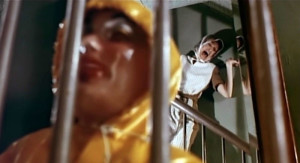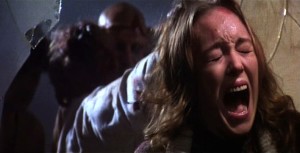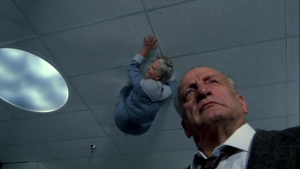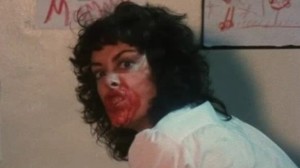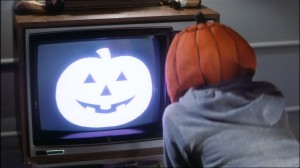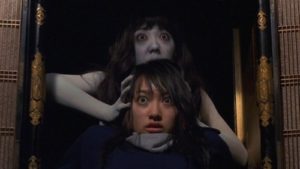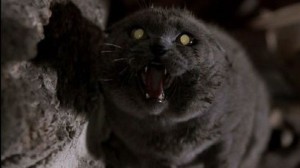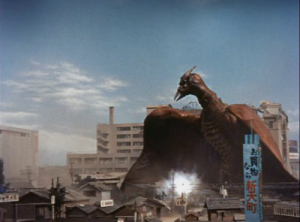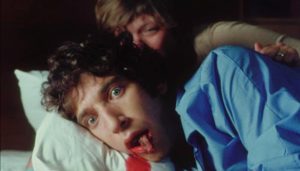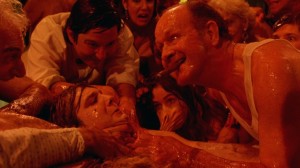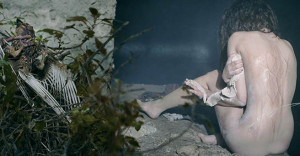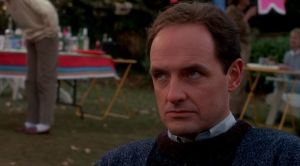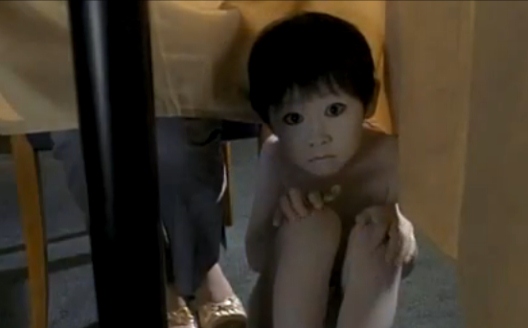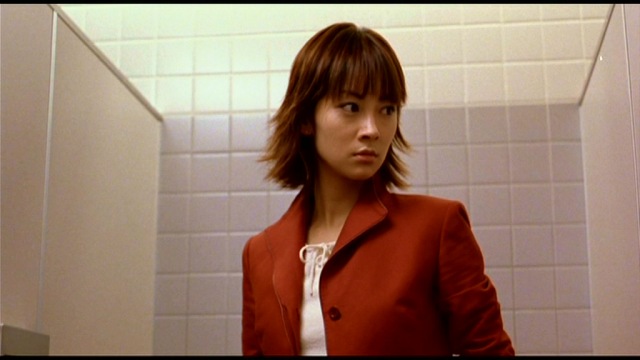
We did it, friends. 31 Days of Fright wrapped up this Monday night, and in total, you raised $1,226 for the TRCC/MWAR, and I watched approximately 47 hours of horror movies and wrote approximately 105,000 (mostly inane) words about said horror movies. And I watched all the movies I set out to*, in the timeframe I intended to watch them! Success! (*The only exception was Stagefright – also known as Stagefright: Aquarius or Deliria – which is apparently impossible to find. Only partially because of its multiple aliases.)
Obviously, I’m overjoyed at the money you raised. The Toronto Rape Crisis Centre / Multicultural Women Against Rape is an extremely valuable resources offering a 24-hour crisis line, counselling, court support, and more! If you missed your chance to donate, several friends are participating in their annual Bowlathon fundraiser, and you can pledge to their teams here.
I suppose, however, that you’re wondering about my state of mind. Well, I suppose you could say I’ve become a bit desensitized to violence and death. The final film I watched was originally rated ‘X,’ and it didn’t even garner a nightmare or moment of true revulsion. So, I’m in a much darker place than I was when I started. (Luckily, it’s now February: the happiest month of the year.) But more than adding darkness to my soul, this month-long horror movie marathon probably subtracted years from my life through lack of sleep. The viewings and write-ups added minimum four hours (usually more like five hours) of work to every day in January, and I usually re-budgeted those hours from the time I’d usually be sleeping and (occasionally) exercising. You don’t need to be Dr. McCabe from The Beyond or Dr. Herbert West to realize those are hours you probably need.
Exhaustion aside, I had a really great time. I was actively engaging in some of my favourite things all month long: watching movies, reading way too much into movies, and working way too hard at an endeavor that means, ultimately, almost nothing.
Thanks so much to all of you – to those of you who donated, who recommended movies, who read these overly long reviews (and there are way too many of you who did that), who watched alongside me (either virtually or beside me on the couch), and who encouraged and supported me by thinking this effort was somehow a good idea Another big thanks to Toronto’s Queen Video and Bay Street Video for existing, as this month of horror movie viewings would have never happened without their extensive libraries and helpful staff. (Please patronize your local video rental store, friends. Most of these films are not available on Netflix!)
Below is an alphabetical index of the full list of thirty-one films. Simply click on the photo to be redirected to that film’s the write-up.
Thanks again!
Alice, Sweet Alice
Forget “drink of this wine, for it is My blood.” How about just pints and pints of the real stuff?
The Beyond
The Beyond, if you think about it, is just a really gory and surreal episode of Love It or List It or The Property Brothers. Like, unless Gordon Ramsay helps out Liza Merril and the 7 Doors, he has no business calling his show Hotel Hell.
Borgman
“Being a gardener in the Netherlands seems like a really dangerous job.”
Candyman
The film opens with a voiceover by (we can assume) the Candyman himself – not to be confused with Rene from Danish pop band Aqua – who asks us while the screen fills with bees, “What’s blood for, if not for shedding?” (I feel like a hematologist would have a lot of good answers to this question.)
Chopping Mall
The best thing about Chopping Mall is its title. There’s not even any chopping in the film – the killer robots literally have no tools or weapons with which to chop!
Deadly Blessing
When Jim starts up his John Deere tractor, you can tell from the look on Hittite elder Isaiah’s face that he’s not going to be the Wilson to Jim’s Tim ‘The Toolman’ Taylor.
The Exorcist III
Filled with My-Dinner-with-Andre-like dialogues (if Andre were a demon serial killer and Wallace Shawn barely said anything).
Flesh Eating Mothers
“Each of us is responsible for our own mother’s actions.” Words to live by.
Halloween III: Season of the Witch
Halloween III‘s willingness to murder children like Little Buddy, along with the real downer of the ending, demonstrates how damaging the filmmakers think children’s marketing really is. (That said, Carpenter has always been willing to kill children in his movies.)
The House with the Laughing Windows
One thing that differentiates The House with the Laughing Windows from many other gialli is the constant reference to World War II, and Nazis having used the village as a staging area of sorts. This, combined with the hidden horrors that happened in the town, seem to implicitly link Italy with the horrors of the Third Reich in a way that few Italian horror movies do. “At first, they came for the fresco restorers …”
The Howling
For an over-the-top monster movie, The Howling gets a lot right about post-traumatic stress.
It Follows
There seems to be strength in numbers. Whether this is or isn’t a tacit endorsement of polyamorous relationships can’t be definitively proven.
Ju-On
Everyone who comes in contact with the house lives the rest of their life haunted until they die. It travels from parent to child, from friend to friend. Could Ju-On be the first great ghost story about transgenerational trauma?
Lake Mungo
A spooky Where’s Waldo?, Lake Mungo makes Paranormal Activity look like an episode of Goosebumps. And not even a very scary one. I will be forever spooked by that figure in the dark Alice finds at Lake Mungo. As it is, I’m irrationally worried about having an image of it on my computer desktop.
Lemora: A Child’s Tale of the Supernatural
Lemora’s town is called Astaroth, which is traditionally the name given to the Duke of Hell, one of the three main demons down there. Which seems like a weird thing to name your town, even in the South.
Paranormal Activity
Prior to one night of paranormal hijinks, Katie is filmed applying deodorant before bed. Is this a thing people do? I have been putting on deodorant at the entirely wrong time of day?
Pet Sematary
Let us take a moment to praise the work of the cat actor who portrayed Church. I have never seen cat-acting like that featured in Pet Sematary. Church was played by seven different cats, but the scene that most impressed me was the death scene. The cat’s movements were so convincing, I was a little worried they just straight-up murdered a cat. Bravo, seven cats who played Church. Bravo!
Possession
In my notes, I have written, “I feel like I don’t understand sex enough to understand this movie.” And I stand by this statement. The film should carry a Surgeon General’s warning that it shouldn’t be viewed by anyone in the midst of a breakup.
Prophecy
I was willing to watch Prophecy for the exploding boy in the sleeping bag alone. No one even told me there’d be a raccoon attack and a chainsaw-axe battle in store!
Re-Animator
One is reminded of the Grand Guignol tradition of French theatre, so over-the-top (and impressive) is the gore. Re-Animator commits to taking the scene to its logical death, then – fittingly – takes it even further. It is the Will Ferrell of horror movies.
Rituals (aka The Creeper)
I once went dogsledding in the Northwest Territories. (It sounds more adventurous than it was.) My dogsledding partner was a surgeon at the Yellowknife hospital. I thought to myself, what great luck to be travelling with a doctor. If we crash or if any sort of crisis happens, I have a doctor right here. But Rituals makes me reconsider how handy it would be to have doctors on hand in an emergency situation.
Rodan
The surprise reveal in Rodan is that there’s not just one Rodan. There are two. This is a Scream-level twist. And Professor Kashiwagi suggests that they are mates. So the love story of the two Rodans parallels the love story of Shigeru and Kiyo. Given this romantic setup, the opportunities for Rodan erotic fan-fiction are limitless.
Shivers
What at first appears to be an upscale, modern apartment complex filled with respectable professionals devolves, within a day, into a den of sex-crazed monsters who assault everyone in sight. And the real trick is, even before the sex-worms entered the picture, there was something very rotten below the surface of the Starliner Towers.
Society
Imagine Pretty in Pink, but instead of Blane and Andie lovingly reconnecting at the prom, Blane invites Andie to a fancy party, then transforms her into a gelatinous puddle of flesh that he consumes to rejuvenate himself. (As long as it has OMD on the soundtrack, I’m still on board.)
Spring
This is supposed to be a romance, but Evan is so insistent on Louise loving him, it becomes pathological, even scary. If Louise didn’t intermittently transform into random monsters, you’d fear for her safety.
The Stepfather
The movie is also a prescient warning that those people who seem like the perfect fathers, the perfect husbands – who quite overtly aim to make that “goodness” their identity – may not be who they seem. A colourful sweater can hide a black heart.
Stir of Echoes
Stir of Echoes: a movie about the existential dread of Kevin Bacon digging a hole. Did you know that making dirt wet makes it easier to dig? I didn’t! Grave-digging tips from Kevin Bacon! That’s why you watch Stir of Echoes.
V/H/S
“Dude, you’re trippin’. I don’t blame you. That’s what trippers do.” – Gary, criminal, philosopher
White Zombie
That the movie is called White Zombie demonstrates what viewers are supposed to see as the true horror of the film. Zombies in Haiti are black. Madeleine very obviously is not. The horror of White Zombie is the horror of a white person being treated like a black person.
The Wicker Man (2006)
The movie is dedicated to Johnny Ramone. Which is confusing to say the least.
Witchfinder General (aka The Conqueror Worm)
Find witches. Get money. That’s the motto of Matthew Hopkins.
